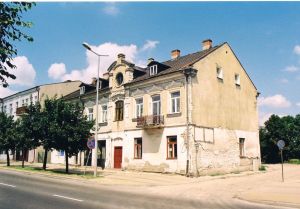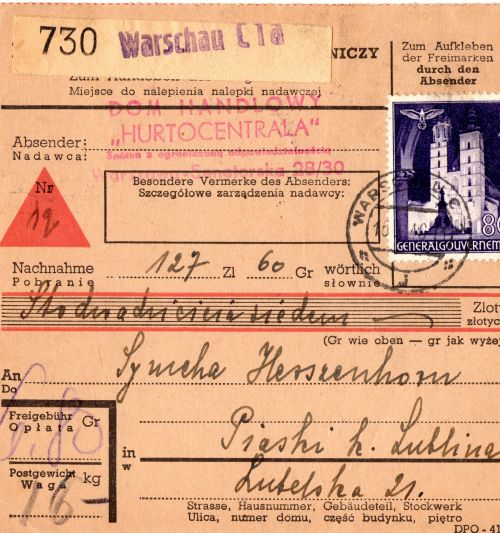Piaski

Piaski 2004
Piaski is located about 20 miles south east of Lublin, and when the Germans and the Soviets invaded Poland in September 1939, Piaski had 4,165 Jews, but many fled at the time when the Soviets withdrew as part of the Molotov-Ribbentrop Pact. The Germans occupied Piaski on 17 September 1939. During the period from February to December 1940, Piaski was a destination, along with Glusk and Belzyce for the Jews expelled from Pomerania. In mid-February 1940, the German authorities removed approximately 1,000 Jews from Stettin. A smaller transport of Jews from the city of Schneidemuhl, another city in Pomerania, took place in March 1940. A Jewish Council (Judenrat) was also established at this time, under the leadership of Mendel Polisecki.

Warschau - Piaski Paketkarte 16-10-1940 (Tall Trees Private Archive)
From 31 December 1940, to early June 1941, Piaski became an open ghetto on the orders of the Kreishauptmann – Lublin Lands Emil Ziegenmeyer. For the Jews, the change initially meant their residential confinement to the area near the synagogue. This area was already overcrowded due to the influx of Jews from Pomerania. Travel outside of the ghetto was still possible, as evidenced by a letter from Max and Martha Bauchwitz, which mentioned that the sick originally could be taken by bus to Lublin for care, but by May 1941, they travelled in straw-covered wagons. At this time, an epidemic of louse-borne typhus had already broken out in Piaski. Max Bauchwitz, a dentist, alongside several Jewish doctors, treated typhus patients in the ghetto hospital and two medical clinics. By June 1941, the Jewish inhabitants of Piaski ghetto numbered 4,803, and this figure included refugees from Krakow, as well as those from Stettin.
From 11 June 1941, to March 1942, Piaski became a closed ghetto. On Ziegenmeyer’s orders, the ghetto was enclosed with barbed wire and a second closed ghetto was established opposite the first on Lublin Street. Piaski’s limited water sources were located in the first ghetto, near the synagogue. Thus the second ghetto’s residents had to cross the street to secure water, but the Jewish Police only permitted crossings every two hours until curfew. The Piaski Judenrat supervised both parts of the ghettos. A Jewish Social Self-Help (JSS) report indicated that just over 10 percent of the Jews were described as skilled or unskilled workers or as professionals. In September 1941, Dr Siegfried of the Jewish Aid Committee (Judisches HilfsKommitee) Lublin-Lands reported that, for the 4,900 Jewish inhabitants, the available space in Piaski amounted to 63,367 square feet or 11.8 square feet per person.
In October 1941, a small group of Jews from Krakow was deported to Piaski. Twenty –seven of them sent a letter to the JSS headquarters in Krakow signed: ‘The Evacuees from Krakow to Piaski,’ pleading with the Jewish welfare authorities to send winter clothing as soon as possible, because they had none. Overcrowding and chronic hunger made the ghetto vulnerable once more to epidemics. Between October 1941 and January 1942, louse-borne typhus once again overwhelmed Piaski’s slender resources. A JSS member in Piaski, Szaje Lindner, repeatedly requested medication and disinfection agents from the JSS in Krakow, to combat the epidemic. Altogether as many as 1,500 Jews in Piaski perished due to epidemics throughout its existence.
From the end of February 1942 to November 1942, Piaski played a leading role in ‘Aktion Reinhardt’ – the annihilation of the Jews in the General Gouvernement. Along with Izbica, Krasnystaw, Rejowiec, it functioned as a collection point / transit ghetto for German, Austrian, Czech and Slovak Jews. The head of Lublin’s Population and Welfare Department, Richard Turk, ordered that Jews from the ‘Old Reich’ and the ‘Reich Protectorate of Bohemia and Moravia’ replace the ghetto’s Polish and Pomeranian Jews, which were being deported to the Belzec death camp. Another official of the same department Fritz Reuter quoted SS- Hauptsturm Hofle, the Deputy of ‘Aktion Reinhardt’ who said: ‘Piaski will be made free of Polish Jews and become the assembly point for Jews coming from the Reich.’
The first deportations from Piaski took place shortly after 16 March 1942, probably to make room for an influx of Jews from the Reich. Approximately 3,400 Polish Jews and Jews from Stettin, who were deemed as ‘unfit for work,’ were marched to Trawniki, where they were held overnight in a barn at the former sugar refinery, together with some Jews from Biskupice. Several hundred of these people died from suffocation overnight. The next day the corpses were loaded onto the cattle wagons along with the living deportees, to be sent to the Belzec death camp.
Transports from the Reich to Piaski began on 23 March 1942, when approximately 1,000 Jews from Mainz and Darmstadt arrived in Piaski. According to Martha Bauchwitz, this transport arrived penniless. Then on 28 March 1942, 985 Jews arrived from Berlin. On 1 April 1942, 1,000 Jews arrived in Piaski from the Theresienstadt fortress ghetto. Working-age Jews from this and the other transports in March 1942, such as Kurt Ticho Thomas, originally from Boskovice, Czechoslovakia were deployed as agricultural workers on nearby farms. The deportations from Piaski to the death camps, via Trawniki, resumed on 6 April 1942, and on 11 April 1942, the German Security Police Transfer Office Piaski, itemised property seized from the Jews recently dispatched to Belzec. Property listed was 8,300.54 zloty, 85 gold rubles, and 5 wedding rings, as well as 45 men’s vests, 2 fur pelts, 9 pairs of children’s mittens and other goods. According to official German records, there were further transports to Piaski on 6 April 1942, when 989 Jews arrived from Munich, and on 25 April 1942, when another 1,000 Jews arrived from Theresienstadt. However, more than 200 of the able-bodied men on each transport were selected in Lublin, probably for the Lublin concentration camp.
On 19 May 1942, Zigenmeyer reported that 6,166 Jews from Piaski had been resettled. The deportation necessitated the re-construction of the Judenrat in Piaski and the Jewish Police as well. Polisecki remained as Chairman, and the Judenrat had two more long- standing members, Moses Drajblat and Josef Aschmann. The nine replacements had arrived on the recent transports from the Reich. They were Moritz Israel Fried, Ernst Schlosser, Siegfried Kugelmann, Fritz Sanger, Hugo Railing, Kurt Hirschmann, Ernst Böhm, Walter Guttsmann, and Friedrich-Wilhelm Kempner. The age range of the new Judenrat was from 28 to 62, and was decidedly middle-class in its composition. The Jewish Police was also re-organised, with Stefan Reinemann oversaw 30 Reich and Protectorate Jews in the force, including one woman Bela Trattner.
On 15 May 1942, the Reich Security Main Office (RSHA) banned Jews in the General Gouvernement from corresponding with relatives in the Reich or elsewhere, effectively cutting Piaski off from the world, apart from the JSS Lublin-Lands somewhat cursory replies to enquiries from relatives. By June 1942, deportations of Western European Jews went direct to the Belzec and Sobibor death camps, which obviated the need for Piaski to serve as a transit ghetto.
The main deportation ‘Aktion’ took place during the period 22-30 October 1942, when some 5,000 Jews were deported to the Sobibor death camp, via Trawniki. On 23 October 1942, 3,000 Jews from the Leczna ghetto were marched to Piaski and from there, they shared the same fate, and were also deported to the Sobibor death camp, via Trawniki.
Also in October 1942, Higher-SS and Police Leader East Friedrich – Wilhelm Krüger, designated Piaski one of the few locations where Jews were allowed to reside in, the so-called ‘Jewish Residential districts,’ this was a ruse to tempt those Jews in hiding to return to the ghetto and thus be deported more easily. In late October 1942, Krüger inspected Piaski to see if the ruse was working. Starting in November 1942, a small forced labour camp for Jews operated in Piaski, but this only lasted until March or April 1943, when the inmates were sent to the Trawniki labour camp.
On 13 October 1943, the revolt at the Sobibor death camp took place, and one of the Jewish inmates Kurt Ticho Thomas returned to the Piaski area and hid with the Polish farmer, for whom he had worked before being deported to Sobibor. The Podsiadly family protected him until the Red Army arrived in July 1944. In 1986, Yad Vashem recognized the Podsiadly family as ‘ Righteous Among the Nations.’
Sources:
The Encyclopaedia of Camps and Ghettos 1933-1945, USHMM , Indianna University Press Bloomington and Indianapolis 2012
Y. Arad, Belzec, Sobibor, Treblinka – The Aktion Reinhard Death Camps, Indiana University Press, Bloomington and Indianapolis 1987
R.O’Neil, Belzec – Stepping Stone to Genocide, JewishGen Inc. New York, 2008
R.Kuwalek, From Lublin to Belzec, AD Rem, Lublin, 2006
Photograph - Chris Webb Private Archive
Paketkarte - Tall Trees Archive
© Holocaust Historical Society 2019

